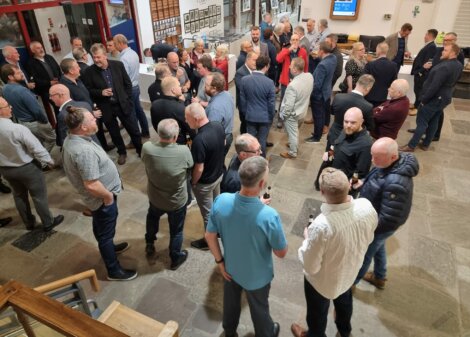Features / An anniversary ‘worth celebrating’: 50 years since construction began on Sullom Voe Terminal
Davie Gardner reports on an event held at the Shetland Museum and Archives on Saturday celebrating the 50th anniversary of construction at the oil terminal
FIFTY years ago, back in 1975, the first turf in the north Shetland mainland was turned on what would ultimately become the Sullom Voe oil terminal.
A massive, hugely complex five-year feat of engineering construction undertaken by around 5,000 workers followed, transforming the area into the then largest oil terminal in Europe with the first oil flowing through it by late 1978.
Over the ensuing decades the resulting development, often simply referred to locally as ‘Sullom’, would have a huge, impact on the community in general.
The economic benefits in particular were rapid and huge, unlike anything Shetland had previously experienced, primarily as regards wide-ranging employment opportunities together with the added bonus of population retention and attraction issues too.
Safe to say, the eventual building of the Sullom Voe oil terminal – officially opened by Her Majesty the Queen in May 1981 – preceded by that initial turf turning back in 1975 – constituted perhaps the single most important moments in the islands’ economic history to date.
In addition, wider positive impact was felt by many businesses and industries well outside the terminal gates. At the height of its throughput in the late 1990s the terminal was handling around 25 per cent of the UK’s total petroleum production, amounting at the time to 1.5 million barrels of oil per day.
The oil industry’s initial need for such a terminal, and the local negotiations relating to that, also heralded – via a unique act of parliament – the 1974 Zetland County Council Act, giving the council various management related powers.
Become a member of Shetland News
In due course it also brought about Shetland’s much admired community oil fund, managed through the Shetland Charitable Trust.
Today, largely due to the oil industry throughput via Sullom Voe, plus astute investment factors surrounding the fund itself, its value to the islands now stands at just short of a staggering half a billion pounds.
This helps fund and support crucial local social and economic development, infrastructural improvements throughout the isles and charitable causes such as Shetland’s network of leisure centres and care facilities, plus providing crucial financial support for local groups, organisations, events and more besides.
The local community, and Shetland Islands Council (SIC) in particular, have also benefitted from the provision of harbour facilities and services at the port of Sullom Voe, operated throughout on behalf of the industry by the SIC.
At the terminal’s operational height in the late 80s and 90s around 600 large oil and gas tankers visited the port on an annual basis, although that number has subsequently declined significantly.
To celebrate the 50th anniversary of that important initial turf turning, current Sullom Voe Terminal operator EnQuest, which took over that role from BP back in 2017, held a celebratory reception for invited guests in the Shetland Museum and Archives on Saturday night.
Present were many long-term employees at the terminal, together with a variety of industry partners including Shetland Islands Council and the Shetland Charitable Trust.
Opening the event, EnQuest UK managing director Steve Bowyer said the aim of the evening was primarily to celebrate the community’s significant role in the construction and operation of the terminal over the fifty-year period, stressing it had very much been a two-way benefit and partnership between the industry and the Shetland community.
He said the terminal was now going through a period of “energy transition” due to declining oil reserves.
However it was now entering another exciting period in its history as it transforms to meet the challenge of providing new forms of cleaner energy, this alongside an ongoing, still long-term commitment to the oil and gas industry, in particular receiving oil from the huge Clair field west of Shetland.
Bowyer estimated that with this in mind it was estimated that the life of the terminal would be extended for anything between another thirty to fifty years.
SIC convener Andrea Manson echoed the benefits to the community over the years, and the authorities hopes for the future too, ahead of a specially commissioned, locally produced video being shown, again to celebrate the 50th anniversary.
The video featured a number of the local folk employed on the site over the years.
One of those is Athur Spence, whose first involvement with the terminal on leaving school back in the mid 1970s was delivering office furniture there.
He ultimately progressed to becoming an industry trainee, eventually becoming terminal manager.
He is currently based in Aberdeen with EnQuest in the role of midstream director.
Spence said his own experience illustrated the employment opportunities of having the terminal located in Shetland, although he was equally quick to point out the dual industry/community benefits too.
“Shetland has helped make the terminal what it was and still is, while it made Shetland what it’s subsequently become too,” he said.
So, fifty years and counting with possibly fifty more to go of one of Shetland’s most important economic success stories. An anniversary and an ongoing partnership worth celebrating indeed.
The associated exhibition is located on the upper floor of Shetland Museum and Archives and will remain in place there for the foreseeable future.
Become a member of Shetland News
Shetland News is asking its readers to consider paying for membership to get additional perks:
- Removal of third-party ads;
- Bookmark posts to read later;
- Exclusive curated weekly newsletter;
- Hide membership messages;
- Comments open for discussion.
If you appreciate what we do and feel strongly about impartial local journalism, then please become a member of Shetland News by either making a single payment, or setting up a monthly, quarterly or yearly subscription.


















































































